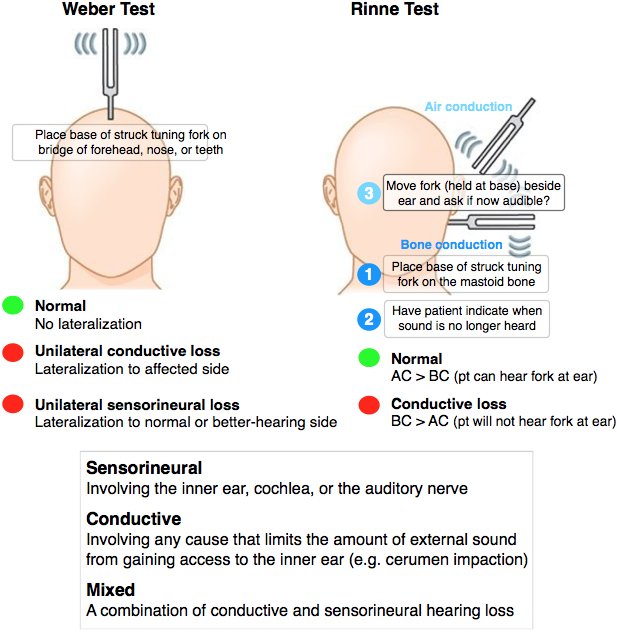

Small ear canal volume suggests ear canal occlusion. The Jerger system is commonly used to classify tympanometric results: For example, acoustic trauma (noise-induced loss) often results in a loss centered around 4 kHz with recovery at higher frequency (i.e., a 4-kHz notch) presbycusis often involves symmetric downsloping loss, worse at higher frequency a fluctuating low-frequency loss is often seen with Ménière′s disease. Patterns of SNHL may be suggestive of certain etiologies, taken together with clinical history and exam. Basic Otorhinolaryngology: A Step-by-Step Learning Guide. (c) The type C tympanogram has a peak in the negative pressure region below −100 daPa, consistent with impaired middle ear ventilation. A type B tympanogram with large volume is seen with the perforation. This indicates immobility of the tympanic membrane, which may be due to fluid in the middle ear or tympanic atelectasis. (b) The type B tympanogram is flat or has a very low, rounded peak. (a) The normal tympanogram has a prominent, sharp peak between +100 and −100 daPa. 3.8 Normal and abnormal tympanogram patterns. A poor word-recognition score, especially out of proportion to pure tone thresholds, suggests possible retrocochlear pathology, such as an acoustic tumor. In a sensorineural loss, bone conduction thresholds typically equal air conduction, and the loss may be due to dysfunction at the level of the cochlea, CN VIII, or central pathways. The loss may be due to dysfunction involving the external canal, tympanic membrane, or ossicular chain or to middle ear fluid. In a conductive loss, there is an air–bone gap on the audiogram, with better bone conduction thresholds, with appropriate masking. Otologic disease may be categorized as conductive hearing loss, sensorineural loss (SNHL), or mixed hearing loss. Red flags should prompt referral to an otolaryngologist (discussed below). Objective(1) Determine whether tuning fork material (aluminum vs stainless steel) affects Rinne testing in the clinical assessment of conductive hearing loss (CHL). 3.8) may suggest various forms of otologic disease. Results of the audiogram and tympanogram ( Fig. Basic Otorhinolaryngology: A Step-by-Step Learning Guide. Strike a 512 Hz tuning fork and place on top of the patients head. (Used with permission from Probst R, Grevers G, Iro H. (d) Audiogram showing mixed hearing loss. (c) Audiogram showing sensorineural hearing loss.

(b) Audiogram showing conductive hearing loss. It is necessary to employ masking (a static type of noise) in certain situations to prevent the nontest ear from detecting the test signal. An audiogram is a graph with frequency (in Hz) plotted on the x axis and intensity (in dB) plotted on the y axis. Conclusion: SPWT can serve as an auxiliary diagnostic tool in the absence of a 512-Hz tuning fork to assist in the identification of the type of HL and to potentially hasten the diagnosis and provision of treatment when indicated.Results of audiometric testing are typically plotted on an audiogram ( Fig. The sensitivity and specificity of the SPWT were 76.9 and 97.1%, respectively. The sensitivity and specificity of the TFWT were 84.6 and 94.1%, respectively. The SPWT was in agreement with the TFWT (at a frequency of 512 Hz) in 55 (92%) patients. Results: Twenty-six (43%) patients were diagnosed with a SNHL, and 34 (57%) with a CHL. They were asked to press a single uncovered smartphone on their forehead and conduct a Weber test by means of the smartphone’s vibration application. Methods: Sixty patients referred to the emergency department due to unilateral hearing loss (HL) were enrolled. Study Design: We conducted a prospective, noncontrolled clinical study. Objective: The aim of this paper was to compare the accuracy of a smartphone-based Weber test (SPWT) with the traditional tuning fork Weber test (TFWT) in identifying and differentiating between sensorineural hearing loss (SNHL) and conductive hearing loss (CHL).


 0 kommentar(er)
0 kommentar(er)
